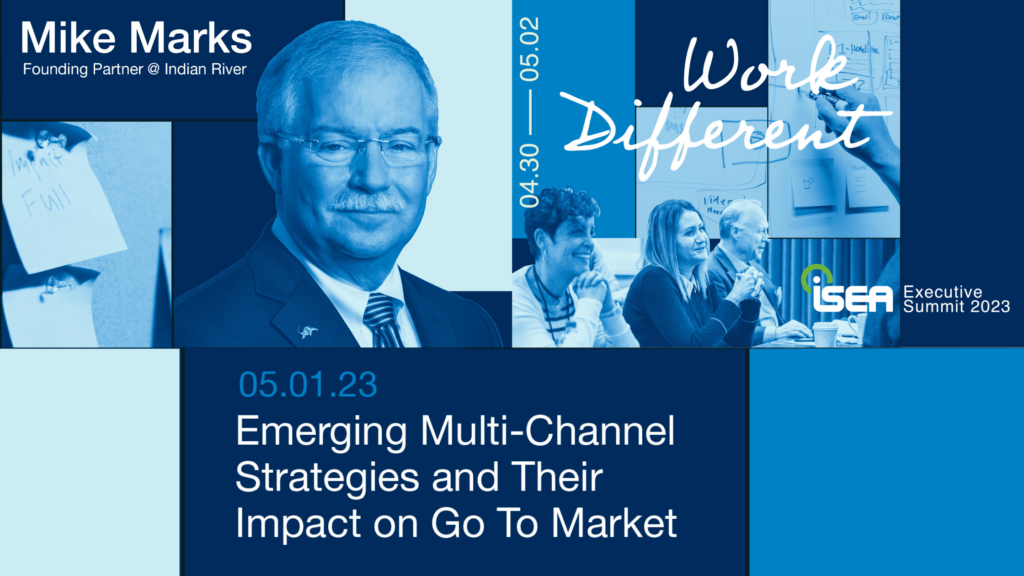An Interview with Mike Marks
Ahead of the 2023 Executive Summit, where Mike Marks (Indian River) will workshop around emerging multi-channel strategies, we asked him a few questions manufacturer execs have recently been asking themselves.
There is still time to register to join us in Houston April 30-May 1.
The Economy
ISEA: Heading into a slowing economy for most sectors, manufacturers need to be vigilant about keeping costs in check. What are some areas where you see manufacturers over-investing when it comes to channel & end-user?
MIKE: Overcompensating channel partners for market-serving activity.
Manufacturers almost always undercompensate channel partners for market-making and overcompensate them for market-serving. If you measure overall growth of distributors, and don’t look into the drivers of that growth, this may be occurring. For example, the growth provided by the large distributors is often driven by acquisitions, which is accurate from an accounting perspective, but often very wrong. In many cases the national acquired an existing distributor so the manufacturer lost that business, and their revenue was simply reported under the acquiror. It is often instructive to go back five years and restate growth rates when these losses are factored in.
The End User
ISEA: How is the balance shifting between economic buyers (lowest price) and safety champions (highest quality & performance)?
MIKE: All market power migrates to the end user over time and safety is no different.
The safety champions typically ring fence ‘specialty products’ keeping their sourcing and specification capabilities. They do this typically with a couple of distributors to ensure that they have access to technical support. While there is not an industry study with definitive results, there are many indications that the power in many industrial facilities continues to shift from the plant floor to the MRO purchasing function. They ringfence with distributors because it provides access to all of their suppliers as well. Manufacturers should begin to consider the customer’s value proposition. The product is wrapped in many other distributor provided service outputs and there is little meaningful differentiation between competitive products. There are economic drivers that can be employed to gain influence over a distributors service offerings.
The Opportunity
ISEA: What are some opportunities for manufacturers to consider to get maximum coverage for their products?
MIKE: Here are three to consider:
- Sell the way the customers want to buy. If they want to buy through distribution, through the Internet or any other place, a manufacturer must incorporate those channels into an aligned go-to-market strategy. When you don’t have channel conflict, it’s a strong indicator of poor market coverage. Channel conflict should be managed with rules of engagement, never avoided.
- Remove uncertainty with channel partners. Reducing uncertainty increases distributors’ willingness to invest in growing your line.
- Improve processes with your distributors with digital transformation. Customers are driving this demand and it is in a manufacturers best interest to help distributors service their customers better with digital tools, such as automated ASNs, SPAs, mobile RMAs, eCommerce, etc.
The Environment
ISEA: We’re seeing an increase in requests from end-users about the environmental/sustainability qualities of a product, country of origin, etc. Where do you see supply chain transparency going over the next couple years?
MIKE: Sustainability is a big concern for many end users.
This conversation is just like the one about adding fluoride to water to reduce cavities in the fifties and sixties. This will be old news and everywhere in less than five years, get over it. If you don’t address sustainability in your business and on your website, you’re already falling behind your competition. Be transparent in where you source your materials, how you package them, and how you’re minimizing environmental impact. There is potentially a first-mover advantage that should be evaluated prior to ignoring it.
Here are some examples from companies in other industries:
The 800 lb Gorilla
ISEA: How should manufacturers view Amazon as part of their GTM strategy?
MIKE: Consider the situation of someone who really needs another strap to a mask on Saturday and it is late Friday afternoon. Are they fine with paying a higher price? How does it help your Customer Experience (CX) if you can easily provide this service level to your end users? If the person pays a higher price on Amazon than they would have paid at their local dealer or distributor (who was closed), then there is no reason to listen to any dealer whining.
They should consider these factors when viewing Amazon as part of their GTM strategy:
- Amazon is a single channel to market among many others and success in market coverage requires that each firm utilize multiple channels. Build your multi-channel coverage map into your GTM strategy prior to determining the role that Amazon could play.
- Amazon is a market-serving channel so ensure that pricing protects your market-making channels.
- Ensure that a cost-effective and very reliable fulfillment center manages Amazon transactions as there are risks if your service level is deficient. Most manufacturer fulfillment centers are not designed for the service levels required for this channel.


